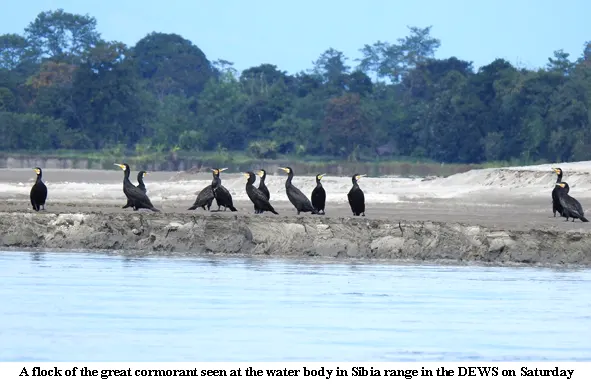[ Prafulla Kaman ]
PASIGHAT, 16 Dec: Smaller numbers of migratory birds have been seen flocking the water bodies of the Daying Ering Wildlife Sanctuary (DEWS) in East Siang district lately, according to the DEWS officials.
Unlike previous years, the winged guests are not seen
chirping in the water bodies of the DEWS and the wetlands of the adjacent areas this winter. Among the winter migratory birds, a few species, such as the ruddy shelduck (Tadorna ferruginea), the great cormorant (Phalacrocorax carbo), and the common merganser (goosander) are arriving at the sanctuary, though lesser in numbers than in the previous years.
The winter migratory birds, which flock the water bodies of the DEWS and the river basins of the Siang and the Lali rivers in mid-November every year, started flocking in the second week of December this year.
The wildlife officials of the DEWS, with the help of the Eco Development Committee (EDC), recently conducted a three-day survey on Asian water birds inside the wildlife sanctuary. The survey team, led by ornithologist and conservationist Tarun Kumar Roy, found only 27 species of birds, including the residents and winter visitors.
Zoologist Roy, who is associated with the Indian Bird Conservation Network and a few international zoological organisations, observed that winter migratory birds are arriving late to the Himalayan region this year. “The reason behind their late arrival might be due to drastic change of climatic conditions or other geographical inconsistencies,” he said.
Roy, who had earlier visited the DEWS and conducted a study on the migratory birds therein, marked the sanctuary as “the finest and biggest wetland of the state.”
Concerned over illegal activities such as fishing in and collecting driftwood from the water bodies of the wildlife sanctuary, he suggested to the authority to “restrain trespass of illegal traders into the sanctuary area.”
Located about 8 kms east from Pasighat, the DEWS is surrounded by the Siang and the Sibia rivers and a branch of the Brahmaputra, thereby providing abundant water bodies and sand bars, making it a suitable habitat for various herbivorous and carnivorous species, besides the migratory and resident birds.





